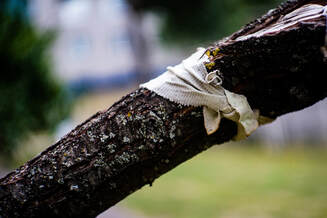 Frost cracks come in late winter to early spring usually on the southwest side of a tree at the site of a branch stub or earlier wound. They happen when the day’s sun heats the underlying wood and bark, creating tissue expansion. Then with a sharp, sudden temperature falls, the outer bark layer contracts, faster than the inner layers. The difference in contraction is mainly severe where there is a damaged area. Tissue in the wound site doesn’t contract as promptly as good wood. The cambium in the wound area has created a different tissue, a barrier zone that has an unlikely chemical and anatomical makeup from ordinary wood. This space becomes an area of structural weakness and when strained by quick temperature change the wood splits along the barrier zone. The strain between the healthy and defective wood leads to the damage. The splitting itself can explode like a rifle shot. The area involved indicates a vertical crack or bulge in the trunk. The space may harden over only to open again in the upcoming wintertime. The area can also let in disease organisms and insects. Vulnerable species are sycamore, ash, tulip tree, apple, maple, crabapple, beech, and horse chestnut. Pest Management Strategies to Use Treat trees fine. Avoid trunk wounds! They can come from mowing, incorrect pruning, and weed whipping. Do not use tar or wound paints on the crack. They disturb the healing. Prune accurately. Offer a clean wound area. If the break is clean with tidy edges and no dangling, loose bark, don’t mess with the trunk. It will heal on its own. If there is a raggedy tear with peeling bark, cut off the affected bark. Then cut around the wound with a sterile, sharp knife. This cut encourages speedy healing and cambium growth. A half inch of bark around the injury could be detached to give create a clean edge. The edges will harden and ultimately close over the wound. Severe damage. If there is a seriously large crack, an arborist can do some bolting to save the tree. |
AuthorWe at Syracuse Tree Service want to help you with your tree service needs, our blog is where we provide helpful tips and ideas for the health of your trees. Archives
December 2020
Categories
All
|
- Home
- Services
- About
- Contact
-
Service Locations
- Liverpool Tree Service
- North Syracuse Tree Service
- Cicero Tree Service
- Baldwinsville Tree Service
- Manlius Tree Service
- Weedsport Tree Service
- Clay Tree Service
- Bridgeport Tree Service
- Lafayette Tree Service
- Fayetteville Tree Service
- Chittenango Tree Service
- Camillus Tree Service
- Onondaga Tree Service
- East Syracuse Tree Service
- Blog
|
Home | Services | About Us | Contact Us
Liverpool | North Syracuse | Cicero | Baldwinsville | Manilus | Weedsport | Clay | Bridgeport | Lafayette | Fayetteville | Chittenango | Camillus | Onondaga | East Syracuse © Syracuse Tree Care 2017
Syracuse Tree Care 4736 Onondaga Blvd Suite 112 Syracuse, NY 13219 (315) 692-0186 |
|

 RSS Feed
RSS Feed